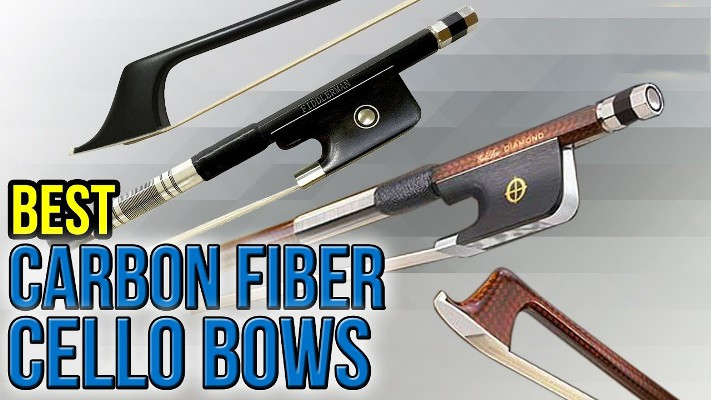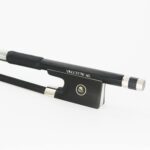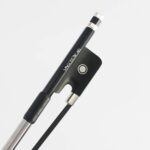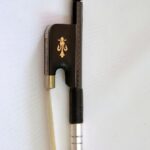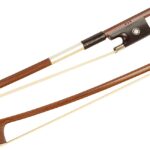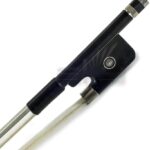Carbon fiber and graphite bows are actually the same thing. They provide a good balance between fiberglass and wooden bows in terms of sound quality, as well as added sturdiness.
Traditionalists in the world of string instruments are skeptical that a carbon fiber bow can ever match up to the sound quality of a wooden bow. It used to be that wooden bows were way better than carbon fiber ones, but technology has come a long way. Nowadays, there are plenty of carbon fiber bows out there that can match their wooden counterparts in terms of quality.
It’s not unusual to spot pros carrying both a carbon fiber and wooden bow. A big plus of the carbon fiber bow is that it won’t be affected by changing weather, unlike the wooden option.
Playing outdoors can be tough for string players, specially in bad weather. But when events like concerts and weddings have been planned in advance, they still had to perform no matter the conditions. Carbon fiber bows are a great option ’cause they’re much more forgiving in challenging weather conditions and won’t just snap or get ruined like regular bows.
Top Carbon Fiber Cello Bows Review
Looking for an upgrade for your first bow? Or maybe an “all-terrain” second bow? Can’t go wrong with a carbon fiber bow! If you’re looking for a carbon fiber cello bow for any one of the reasons mentioned or something else totally, check out the different options out there across several budgets. Here are some of the best carbon fiber bows for cello available today. The price range for these bows is pretty wide—you can get a quality one for less than $50 and some for close to $500.
1. CodaBow Diamond NX Carbon Fiber 4/4 Cello Bow
This bow might be pricier than the other options here, but it has tons of features and great quality that make it well worth the cost. Don’t worry about the durability of this bow – it’s made from the same material used in bulletproof vests. Plus, it looks pretty cool with the diamond weave finish!
CodaBow is a unique company, founded by a multitalented group comprising of scientists, aerospace engineers, and bowmakers. Their collective expertise and distinct skillsets have come together to create exceptional carbon fiber cello bows of superior quality.
CodaBow’s bows are all made in the USA, and they have unbeatable sound quality – even better than wooden bows that cost a lot more! It seems like a lot of people who have used this bow have been pleased with it, both experienced and inexperienced archers. They praise its ease of use, lovely sound and perfect balance. If you just got this bow, one piece of advice someone who already has it would give is that it’ll need a bunch of rosin when the strings are fresh.
2. JonPaul Bravo Model Carbon Fiber 4/4 Cello Bow
This carbon fiber cello bow is perfect for professionals who are on a budget. It’s way cheaper than premium bows which cost around $1500+ – this one costs only around 1/3 of that! It has all the features as the high-end models but at a much more affordable price.
People who use this bow praise not only the great sound they get out of it, but also love the sensation that comes with playing. The design of this bow and frog makes it comfortable to play with, which is important if you’re playing in groups or practicing a lot.
This lightweight, well-balanced bow is a great carbon fiber cello bow for advancing cellists. It works in almost any environment, like outdoors, indoor pits or tight spaces.
Pros:
- Modeled after bows crafted by the greats.
- Stunning, classic look.
- Strong, waterproof carbon fiber construction.
Cons:
- Not for non-serious students and players.
- Pricier than other bows we’ve reviewed.
3. CodaBow Prodigy Carbon Fiber 4/4 Cello Bow
CodaBow Prodigy, made in the USA, has a Blended Acoustic core rather than the Blended Kevlar of the Diamond. It’s around $100 cheaper and still has that great diamond weave finish like its pricier counterpart. CodaBow was founded by three diverse professionals – a composite scientist, aerospace engineer and bowmaker. Their skills combined allowed them to create a very high-quality carbon fiber cello bow.
Looks don’t always tell the story when it comes to instruments, but this bow looks and sounds amazing! One user of this bow said switching from their old one to this one made them feel like they have a brand-new cello. He does warn that it may take some time to get used to because it’s quite hard, not as much give compared to other bows. However, with a bit of practice, you’ll be able to make gorgeous sounds with this bow – definitely worth the effort!
This bow wouldn’t be the best choice for a newbie but it’s really great for players who are transitioning to another instrument or just want to upgrade their equipment and take their playing to the next level.
Pros:
- Comparable to a Pernambuco bow, at a lower price.
- Well made.
- Well balanced.
Cons:
- May be too quiet.
- Nickel fittings.
4. Fiddlerman Carbon Fiber Cello Bow
This awesome carbon fiber cello bow looks just like a fancy wooden one, but only costs $100! This bow looks and weighs the same as the Brazilian wooden bow, Pernambuco.
People who’ve used it have said it feels very similar to a woodbow too, making it a great alternative. Everyone agrees that you can get a great bow for an affordable price.
5. The Piano Guys Carbon Fiber Bow – Best Any-Genre Bow
The Piano Guys created a bow that offers the sound of wood, but with greater strength and better protection against water/humidity. It’s designed to last longer and give more consistent performance.
TPG bows are perfect for any genre, so you don’t have to stick to the classical style. They provide great performance which also makes them look stylish. We believe they’ve definitely achieved their goal!
Combining carbon fiber with classic ebony frog and silver fittings makes this bow look and sound superb. No need to worry if you have any issue as it’s covered by a lifetime warranty and you’re sorted.
You’ll be getting top-notch materials as well as a durable bow. The only downside is that it might not be heavy since the weight of the bow isn’t stated. Going by the shipping weight of 2.71 ounces, we’re assuming that it’s about 2.46 ounces.
Pros:
- Lifetime warranty.
- Waterproof.
- Stylish.
Cons:
- May not be stylistically appropriate for an orchestra.
- Slightly thicker than you may be used to.
6. VingoBow Black Mongolia Horsehair Carbon Fiber Cello Bow
This cello bow is made of carbon fiber and has Mongolian horse hair. There’s also a high density ebony frog fixed with nickel silver fitting. Even though it might be pricey, VingoBow is an expert in bows and the quality isn’t compromised.
For more advanced players, it’s probably not the right bow but it can work perfectly as a step-up bow for beginner and early intermediate ones. People who use this bow love the sound it makes and the quality of the hair is great. It’s not as agile as other bows available, but it’s worth the price for a beginner.
7. VingoBow Black Carbon Fiber Cello Bow
This carbon fiber cello bow has a great balance of strength, flexibility, and cost-effectiveness. It’s priced at under $50 which is ideal for those who don’t want to splurge on expensive wooden or carbon fiber bows.
Folks who’ve tried this bow really appreciate it for its perfect blend of balance and quality. It’s lightweight, which may not suit those of you who want a heavier bow; however, it’s an awesome low-cost option if you’re looking for a light carbon fiber cello bow.
8. Vio Music #680 Carbon Fiber Bow
The Vio Music carbon fiber cello bow packs a lot of features such as an ebony frog, natural Mongolian horse hair, and a nickel silver mount for an attractive price. It’s a really nice bow! If the bow that came with your cello isn’t working well and you don’t want to invest in a pricier one, this is the perfect alternative.
It’s great starting point without breaking the bank! Newbies who’ve used this bow have really been impressed. It offers a great sound and feel compared to basic beginner bows. Experienced players may prefer something more advanced, but for those just starting out it’s perfect for them to hone their cello skills.
9. Mivi Classic Pernambuco Cello Bow – Best Classic Wooden Bow
MIVI’s cello bows are carved and strung with Mongolian horsehair by expert luthiers. Through their extensive knowledge and dedication, each bow meets the highest quality standards.
This bow is crafted from the usual, classic Pernambuco wood with an ebony frog, which is often used on stringed instruments. Plus, the fittings are your typical silver that last a long time.
The classic bow is super lightweight and doesn’t have an exact weight – making it perfect for beginners. Plus, it’s quite affordable compared to other more professional alternatives, so you can upgrade later on if needed.
Having rosin included makes it a great choice for anyone just starting out – as you won’t need to buy extra bow accessories. This is an amazing deal with unbeatable value.
Pros:
- Natural bounce.
- Classic design with a beginner price point.
- Comes with rosin.
Cons:
- Not too strong.
- May not be suitable for professional players.
10. Sky Satin Carbon Fiber Bow
This stylish & lightweight carbon fiber cello bow is hand-carved with a unique satin pattern and eye-catching abalone inlays. It’s made of hardwearing Mongolian horsehair which makes it extra sturdy and gives you great response and control.
People who use this bow are really impressed with its weight and quality. They think it’s a great deal for such an affordable price.
Pros:
- Handcrafted.
- Well balanced.
- Soft on the fingers.
Cons:
- Quality of the screws is questionable.
- Takes a while to break in.
Carbon Fiber Bows vs. Pernambuco
Pernambuco is still the go-to material when it comes to sound quality, but carbon fiber has superior durability. If you’re trying to decide between getting a wooden or carbon fiber cello bow, our advice is to get one of each! That way you have the best of both worlds.
If you switch between two basses, you can still get great sound quality and durability even if you’re playing aggressively. That’s what the pros do, so don’t miss out!
Conclusion
Of all the bows we tested, The Piano Guys Carbon Fiber Cello Bow was definitely the most impressive. It’s amazingly strong yet lightweight – perfect for those looking for something a bit different than your classic bow.
Carbon fiber bows are way more durable than wooden bows. Plus, they don’t absorb any moisture so you don’t have to worry about them warping or swelling.
Check out the JonPaul Avanti Model if you’re looking for a more timeless bow. It’s high quality and built to last, so you’ll get your money’s worth despite its hefty price tag.
FAQ for Best Carbon Fiber Cello Bows
What types of cello bows exist?
Cellos aren’t as easy to understand as you might think – there’s actually three main types. You have wooden, carbon fiber and fiberglass ones. The strength, sound and cost of the cellos all depend on what material is used in their construction.
What is wooden bows?
Wood bows have been around forever and are still very popular with cellists. Most cellists have a wooden bow in their collection, mostly made of Pernambuco wood from Brazil. This wood is especially known for its sound quality and other benefits.
The MIVI is an example of a Pernambuco bow with a traditional look and feel. Cheaper wooden bows are usually made from brazilwood which is also Pernambuco, but lower-quality parts of the wood. The sound may not be as good but it’s a great option for those on a budget or just starting out.
What are the advantages of carbon fiber bows?
Carbon fiber bows have it all – strength, sturdiness and beautiful sound. Plus, they are more waterproof than wood which is great for longterm use. Wooden bows can absorb moisture from the air over time and become warped or damaged, unlike carbon fiber bows.
Back in the day, it was quite tough to get a wooden-bow sound from a carbon fiber bow. Nowadays, this isn’t an issue as there has been a lot of progress in this field, some even saying carbon fiber bows are better than traditional ones. It really comes down to personal preference, so many cellists carry both types of bows.
How to hold a cello bow?
As a beginner cello player, it’s important to learn how to hold the bow correctly. Make sure the frog (the part at the end of the bow) is in your right hand, and that the rest of the bow is pointing away from you. This will help avoid any unnecessary accidents.
Put your thumb between the leather pad and the stick, with it closer to the frog. Then loosely cup your other fingers over the wand. To get a more stable grip, position your second finger parallel to your thumb on the other side of the stick.
When playing the cello, having the right bow grip is essential. You don’t want it to be too slack or too tight – a balance between stability and flexibility is best. Don’t forget to move your fingers slightly as you draw the bow back and forth – this will help with your dexterity and playability.
If you want to move the bow smoothly, keep your arm slightly loose without overdoing it. Keep the weight of the bow even while playing so that you can create the perfect sound.
What is the optimal weight of a cello bow?
Your bow weight must match the size of your cello. While full-size instruments have mature players, the younger ones will have smaller and lighter bows. Make sure to keep this in mind when buying a bow for a young player and check that all the bows we’ve mentioned here are full-size.
The usual weight of a bow is between 2.29–2.82 ounces, but that’s just an average. The most important thing is to pick the weight you feel most comfortable playing with – that matters more than anything else!
Before making a purchase, it’s ideal to try out different weights at a music store. If that’s not an option, order some online and return any you don’t like. Just keep in mind that this process could end up costing you more.
How to determine a cello bow is suitable for me?
In the end, it mostly comes down to personal preference. If you’re struggling to decide, think about this: does your bow feel heavy? If it’s hard to keep steady and control, then that’s a sign it won’t be comfortable in the long run.
If you want to be able to play well on your instrument, it’s important that you get a bow that feels balanced in your hands. If it’s too heavy or light, then it will be harder for you to master the right technique.
Does the weight of the bow affect the sound quality?
You need to put the correct amount of pressure on the strings to get beautiful cello sounds. Heavier bows can be really helpful in this regard, as their weight does most of the job for you, resulting in a fuller sound with less effort.
But if you get a bow that’s too heavy, it can be exhausting to use. You’d be putting in extra effort just to make music with it and that kinda defeats the purpose.
Having a heavier bow doesn’t automatically make it better than a light one. Even if you want your bow to produce a bigger sound, you’ll need to press it harder, but not too hard as that’ll alter the actual sound.
